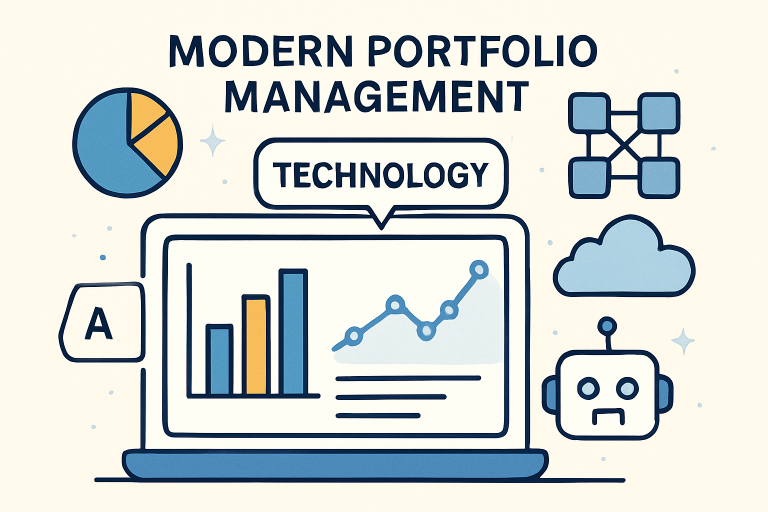Technology
How Technology Is Simplifying Portfolio Management
Key Takeaways:
- Advancements in technology are streamlining portfolio management processes, bringing greater efficiency and accuracy to the industry.
- Artificial Intelligence (AI) and Machine Learning (ML) are reshaping investment strategies and risk management.
- Blockchain technology is enabling unprecedented transparency and security in asset management.
- Automation is reducing manual workloads, allowing for instant portfolio adjustments and streamlined reporting.
- Big data and advanced analytics are empowering managers with deeper, real-time investment insights.
Technology has sparked a revolution in the world of portfolio management, enabling investors and financial professionals to navigate complex markets more easily, execute trades efficiently, and deliver personalized investment experiences. One of the main driving forces behind this evolution is the emergence of powerful digital tools and portfolio management software designed to automate manual tasks, boost accuracy, and provide real-time insights. As more institutions adopt these solutions, the barriers to efficient asset management continue to fall.
Modern technology isn’t just about speeding up processes; it’s about enabling decision makers to react to dynamic market forces swiftly and effectively. Portfolio managers can access a wealth of market data, use predictive models to assess risk, and employ advanced analytics to uncover opportunities that would have been difficult to identify just a few years ago. The innovation is evident in everything from order execution to compliance management—allowing investors to focus on strategic goals rather than operational challenges.
Sophisticated digital infrastructure also makes scalability more attainable, enabling firms to service a greater number of clients and assets without compromising performance or compliance. Robust data privacy standards and security enhancements have reinforced confidence in using cloud-based solutions for portfolio oversight, further fueling digital transformation.
Increasingly, technology is bridging the gap between investor intent and investment action. From the initial allocation through every rebalancing decision, digital tools facilitate precise, real-time control—from anywhere in the world and on any device. The result is a financial ecosystem that is more responsive, intuitive, and aligned with best practices.

The Role of Artificial Intelligence in Portfolio Management
Artificial Intelligence (AI) is a game-changer for investment professionals, automating the complex process of sifting through vast volumes of structured and unstructured data. AI models can analyze everything from regulatory filings and earnings reports to news articles and social signals, often in a fraction of the time it would take a human analyst. By detecting subtle patterns and relationships, AI is enabling more precise risk assessment, customization, and predictive modeling in portfolio management. This allows managers to adapt strategies quickly, improving both return potential and downside protection. As AI continues to evolve, its integration with advanced analytics and machine learning is reshaping how investment decisions are made. Ultimately, this technology empowers professionals to make more informed, data-driven choices with greater accuracy and speed.
Blockchain Technology Enhancing Transparency
The impact of blockchain on portfolio management is undeniable. With its ability to provide tamper-proof transaction records, the technology eliminates many pain points associated with asset verification and account reconciliation. Blockchain enables instantaneous settlement and verification, thereby minimizing errors and delays. It also introduces new possibilities such as fractional ownership and tokenized assets, which enable more granular management of diverse portfolios without compromising security. Greater transparency ultimately leads to higher trust between investors and their advisors.
Automation Streamlining Operations
Automation is reducing operational headaches and manual interventions in portfolio management, such as trade execution, rebalancing, and compliance monitoring. Many firms now leverage algorithmic trading and automated reporting systems to handle the repetitive, rules-based tasks that once took up significant staff time. As a result, portfolio managers can focus on strategic decisions while reducing the risks of manual errors. Improved workflows also extend to tasks such as performance attribution, tax-awareness management, and integrated compliance reporting.
Data Analytics Driving Informed Decisions
Data analytics and the rise of big data have transformed decision-making in investment management. With the capabilities to process immense volumes of data, portfolio managers can analyze historical market patterns, macroeconomic indicators, and even real-time market movements to inform their strategies. Predictive analytics, including machine learning models, help managers forecast market moves, manage risk proactively, and enhance overall portfolio construction. For example, many managers now use scenario analysis and backtesting to stress-test models before implementing them in live portfolios.
Real-Time Performance Tracking
Modern portfolio management platforms equip advisors with real-time performance tracking. This enables consistent monitoring and rapid response, allowing advisors to optimize portfolios without delay. Whether responding to market movements, economic shifts, or client-driven goals, managers have the insights they need at their fingertips—significantly enhancing agility and client satisfaction.
Enhanced Communication and Collaboration
Technology has significantly enhanced communication throughout the financial ecosystem. With shared cloud environments and collaboration apps, team members can work together regardless of location and communicate seamlessly with clients. Instant document sharing, real-time status updates, and synchronized dashboards keep all stakeholders informed, reducing lag time in approvals and changes and thereby strengthening the overall investment process.
Personalized Investment Strategies
Technological advancements enable financial advisors to go beyond one-size-fits-all investment products by creating highly customized portfolios based on individual risk profiles, time horizons, and specific values or ESG (environmental, social, and governance) criteria. Personalization at scale is now possible thanks to AI-powered recommendation engines and integrated portfolio modeling tools. Investors can now access tailored strategies that once required hefty minimums and bespoke service, enhancing satisfaction and results.
Conclusion
The convergence of AI, blockchain, automation, and data analytics is fundamentally changing how portfolio management operates. Technology is not only streamlining traditional workflows but also raising the bar for accuracy, transparency, and personalization. In this rapidly evolving environment, adopting cutting-edge tools is crucial to staying ahead and delivering the level of service modern investors expect.











